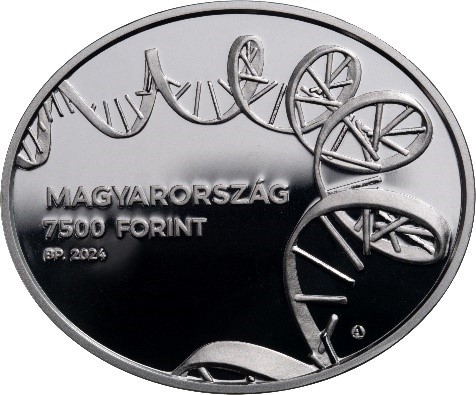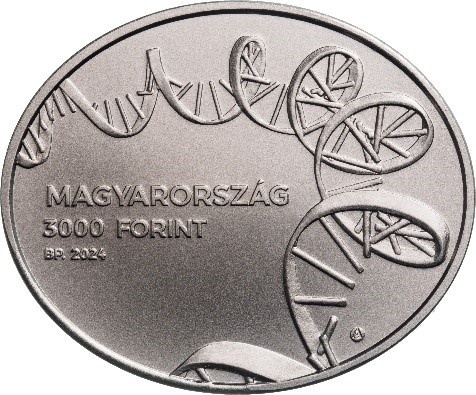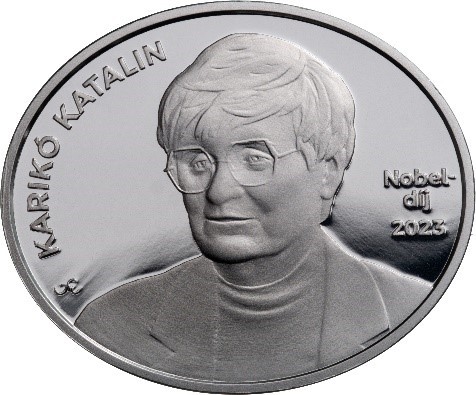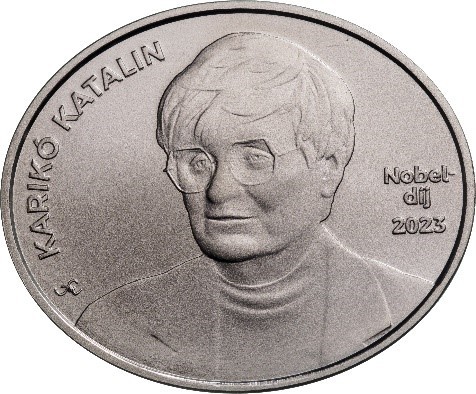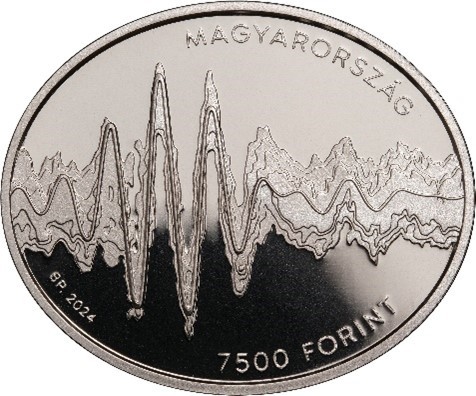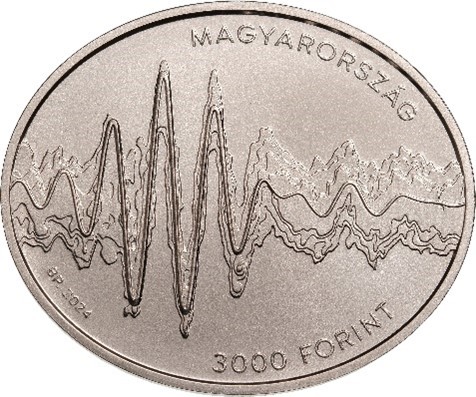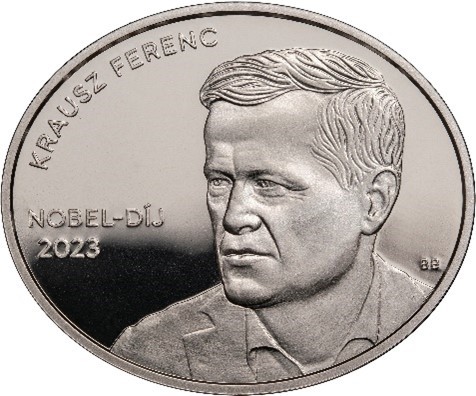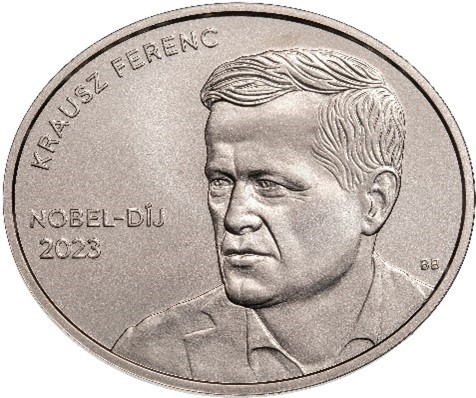20 June 2024
On 19 June 2024, the Magyar Nemzeti Bank will expand its series of collector coins presenting Nobel Prize winners of Hungarian origin and their work by two additions. The 8th and 9th items of the series, which began in 2012, honour Katalin Karikó biochemist, the first Hungarian woman to win the Nobel Prize, and Ferenc Krausz, winner of the Nobel Prize in Physics. Both collector coins will be issued in two versions: silver with a face value of 7,500 forints and non-ferrous metal with a face value of 3,000 forints. The ‘Karikó Katalin’ collector coin was designed by applied artist András Szilos and sculptor Mihály Fritz and the ‘Krausz Ferenc’ collector coin by applied artist Balázs Bitó.
At the ceremonial coin presentation, the Governor of the MNB György Matolcsy highlighted that the 14 Nobel laureates are role models for all Hungarians, but especially for those working in the field of social sciences, including those working in the field of economics. He said that the MNB has been working for years to raise economics to the level of natural sciences, therefore the new sustainable economics can learn a lot from the field of natural science. György Matolcsy called today’s event the hundred-year-old MNB’s greatest, as what could be a greater honour for the Bank than being able to celebrate a money-related event along with our scientists.
In 2023, Karikó became the first Hungarian woman researcher to win the Nobel Prize in Physiology and Medicine – jointly with Drew Weissmann – for laying down the foundation of mRNA-based medicine. The latter, among other things, made possible the swift development and practical application of new types of vaccines against the coronavirus. Her further research centres around RNA injected into tumours, autoimmune diseases, as well as vaccination against cancerous diseases. The University of Szeged awarded Katalin Karikó the title ‘Honorary Doctor of Science’, and she is a member of 10 academies, including the Hungarian Academy of Sciences, as well as the recipient of the Széchenyi Prize and the Saint Stephen Order of Hungary. In addition to the Nobel Prize, Karikó has thus far received over 130 Hungarian and international prizes and awards in recognition of her pioneering and globally significant work in biochemistry. In her opening speech, the Professor said that although it is her husband who collects coins while she prefers to focus on research, the latter requires money. Looking back on her career, she recounted that she lost her job and ran out of money on several occasions, but instead of moaning she focused on making fortune-reversing decisions. By way of advice, she told the audience that one must always focus on decisions that produce results, and she regards her life path as a series of making such decisions.
The Royal Swedish Academy of Sciences has decided to award the Nobel Prize in Physics 2023 to Ferenc Krausz, Pierre Agostini, and Anne L'Huillier for experimental methods that generate attosecond pulses of light for the study of electron dynamics in matter. Their findings make it possible to observe and measure fast and short-term phenomena that could not be accurately studied before. Ferenc Krausz is acclaimed in the fields of theoretical and experimental physics alike. He is currently the director of the Max Planck Institute for Quantum Optics in Germany and head of the Department of Experimental Physics at the Ludwig-Maximilians Universität in Munich. Ferenc Krausz has been a member of the Hungarian Academy of Sciences since 2007. Ferenc Krausz said that it is touching, moving and perplexing when one is portrayed on a coin, especially when following in the footsteps of other Hungarian Nobel laureates that he has looked up to all his life. In his opinion, we as a nation are fortunate to have so many excellent scientists, and he emphasised that if we also count those who did not receive a Nobel Prize despite deserving it, then the potential number of Nobel Prizes would be closer to 20. At the end of his speech, he stressed the importance of working with a good team, as it is the key to achieving outstanding results.
On 19 June 2024, the Hungarian Nemzeti Bank will issue a silver collector coin with a face value of 7,500 forints and its non-ferrous metal version with a denomination of 3,000 forints, named ‘Karikó Katalin’ and ‘Krausz Ferenc’. The primary role of the collector coins issued to honour these 2023 Nobel laureate scientists is to transfer value and to raise awareness. They are not to be used in everyday payments. The face value displayed on the collector coins is meant to preserve their value to collectors.
The oval-shaped coins will appear as the 8th and 9th items of the collector coin series presenting Hungarian Nobel Prize winners. Their design will be in accordance with the series’ thematic concept. One side of the coin will feature a depiction of the Nobel Prize laureate with the inscription ‘NOBEL-DÍJ’ (Nobel Prize), as well as the year the prize was awarded to them. The other side of the coin will feature the findings of the research or the work for which they received a Nobel Prize.
In the spirit thereof, the ‘Karikó Katalin’ coins’ obverse features a stylised representation of a spiral of a modified messenger ribonucleic acid molecule (mRNA) as a central motif. Below the representation, on the left side, on three lines, one below the other, the inscription ‘MAGYARORSZÁG’ (Hungary), the denomination ‘7500’ or ‘3000’, the inscription ‘FORINT’, the mint mark ‘BP.’ and the mint year ‘2024’ can be read. On the edge of the right side of the obverse, at the bottom, is the designer’s mark of the metal artist András Szilos, the designer of the obverse.
Obverse of the ’Karikó Katalin’ collector coins
|
Silver collector coin |
Non-ferrous metal collector coin |
The reverse of the ’Karikó Katalin’ collector coin features the portrait of the researcher. To the right of the portrait, in three lines, one below the other, are the inscriptions ‘Nobel-’ and ‘-díj’ (‘prize’) as well as the year 2023 (the year the Nobel-Prize was given out). On the reverse’s left side, in the upper corner along the edge, the inscription ‘KARIKÓ KATALIN’ can be found, and below is the signature of sculptor Mihály Fritz, the designer of the reverse.
Reverse of the ’Karikó Katalin’ collector coins
|
Silver collector coin |
Non-ferrous metal collector coin |
The obverse of the ‘Krausz Ferenc’ collector coin shows a stylised representation of light pulse ‘scanned’ using what is called ‘Attosecond Streaking’, considered a basic tool of the attosecond measurement technique. The compulsory design elements of collector coins are placed on the obverse: on the side of the obverse, along the edge, in the right upper legend, is the inscription ‘MAGYARORSZÁG’ (Hungary), while the bottom right shows the denominations ’7500’ and ‘3000’ and the inscription ‘FORINT’; on the bottom left is the mint mark ‘BP’ as well as the mint year ‘2024’.
Obverse of the ’Krausz Ferenc’ collector coins
|
Silver collector coin |
Non-ferrous metal collector coin |
The reverse of the ’Krausz Ferenc’ collector coin shows the Nobel Prize winning scientist’s portrait. To the left of the portrait, in two separate lines, one below the other, are the inscription ‘NOBEL-DÍJ’ (Nobel Prize) and the year 2023, signalling the year the Nobel Prize was awarded, as well as the inscription ‘KRAUSZ FERENC’ along the edge. On the edge of the right side of the reverse is the designer’s mark of applied artist Balázs Bitó.
Reverse of the ’Krausz Ferenc’ collector coin
|
Silver collector coin |
Non-ferrous metal collector coin |
Similarly to the other pieces in the series, both collector coins are oval-shaped with centrelines of 30x25 mm, their edges are smooth. The coins with a face value of 7,500 forints were struck in 925‰ silver and the non-ferrous metal coins with a face value of 3,000 forints are made from an alloy of copper (75%) and nickel (25%). The silver coins weighing 12.50 grams are made in proof finish and the non-ferrous metal coins weighing 10.30 grams are made in BU finish. The collector coins ‘Karikó Katalin’ and ‘Krausz Ferenc’ are issued in limited edition: 6,000 pieces can be made of each.
In order to promote the role of these collector coins to transfer value and raise awareness as widely as possible, the silver coins ‘Karikó Katalin’ and ‘Krausz Ferenc’ will be available for purchase for three months, while stocks last, and the non-ferrous version for one year from the date of issuance, at face value in the webshop (https://www.penzvero.hu/) and coin shop of Hungarian Mint Ltd. (Budapest, distr. V, 7 Báthory street), the producer and the distributor of the coins, starting from 19 June 2024.
